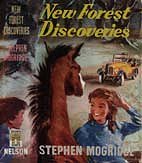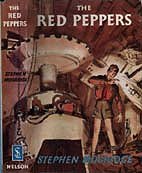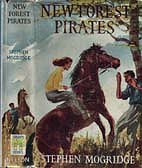| bc |
Stephen
Mogridge The "New
Forest" Series The core location was, as you might expect, the New Forest and, just like Malcolm Saville's Shropshire, that area of the countryside seems to be infested with crooks and wrongdoers. There was a clever attempt to appeal to both boys and girls in this series, for the central two characters were a neatly contrasting brother and sister who take it in turn to be involved in the various adventures that come their way. They have a circle of friends who live close by and play an important part in their attempts at sleuthing. Ponies play an important part in each story and other animals have important roles to be filled. The children's different hobbies and interests are also neatly woven into the scheme of the plots. The age of the characters would seem to be from twelve to fourteen with the target audience being just a little younger. Interestingly, the children, who all clearly belong to well-to-do families, do not go to public school. In fact, in "New Forest Pirates" Patricia's mother threatens her with deportation to a boarding school if her next report does not register signs of improvement. New Forest Regulars Ti (real name Ann Burnett). She is known as Ti because she is very small for her age. She would like to believe the Ti was short for Tiger and not Tiny. Less emotionally fragile than Patricia, she too has a pony, Marigold, but her love is less all-consuming and she very often brings a much-needed dose of common sense into Patricia's wildest worries about her beloved Star. Ti's special talent lies in the puppet theatre for which she creates her own figures. She has a head full of auburn curls and is always a pleasant and positive personality. Freddy Guise Sometimes he is called Freddy the Freckled or even just Frec by his sister. He is small and bespectacled and has a riot of freckles on his face (obviously) .Another pony-lover (his is called Susanna), he lives at Goatspen Hall with his sister. His ambition is to be an electrical engineer and he fulfils the role of boy boffin. He is capable of mending radios, rigging up burglar alarms and even starting cars without their ignition keys. Freddy is also often very good at puzzling out the reasons behind the behaviour of other people and is shown to be sympathetic to those in trouble. Fiona Guise She is tall and graceful with dark hair and friendly brown eyes. The family freckles have only slightly dusted her face. She too is a skilled horsewoman and her pony is called Maid Marion. Like Ti Burnett, Fiona is also portrayed as more level-headed and understanding than the volatile Patricia. Julia Clarke is a chatterbox and loves skating. She is rather on the plump side and not very tall. When she rides her bike a short distance she frequently gets out of breath. She has raven-black hair and is always changing its style from pony-tail to plaits and back again. Everywhere she goes Julia takes a constant supply of food – chocolates, sweets, biscuits. Despite her enormous food consumption Julia is full of energy and vivacity. Her clothes express this liveliness, though the writer often makes the point that she walks around oblivious to the alarming clash of colours in what she is wearing. Julia's parents own a cabin cruiser on the Lymington River which features in several of the stories. Apart from the ponies already mentioned, the Deverill family have a small collection of pets. The most interesting of these is Caesar, the Boxer dog. He looks like the ideal deterrent to thieves but, when confronted with a dangerous situation, it doesn't take long to find out that he is all bark and no bite. A Typical "New Forest" Story The reader becomes more sympathetic to Patricia when it is revealed that a particularly nasty sort of petty criminal is proving a threat to the local ponies. These villains are stealing the horse-hairs from the ponies' tails and leaving them both mutilated and unable to cope effectively with the swarms of summer flies. The book then evolves into the familiar pattern of a New Forest adventure. A new character, quite often female, is introduced into the traditional group of friends and participates fully in one of their adventures. In "New Forest Discoveries" it was Elaine, the talented dancer with the tremendous temper who believed that her parents didn't love her. "New Forest Pirates" offers the more attractive figure of Yvette, the young French girl, who is imported to save Patricia's accent in stead of sending her into tearful exile. Yvette is a sport. She mixes well with the family and helps Bill with his detecting. The "Pirates" in this book are a gang of hi-jackers who are ready to steal any cargo from the lorries that cross the New Forest or come from the Southampton or Winchester areas. To tell more would be to spoil the plot. Freckled Freddy once again proves a wizard at electrical gadgets. The local police inspector, Mr. Foster, again seems to think nothing of the children coming up with vital clues. The criminals' secret code is an intriguing one for any child reader to try to solve, though why it baffled the best brains at Scotland Yard is unfathomable. For once all Patricia's worries about attacks on Star are proved to be well-founded. The book started with her being forced to sit for a passport photograph; the book ends with her being both grateful and relieved that her father had insisted. By the last page of the adventure Patricia has completely reversed the image of the self-centred and rather petty girl that she projected for a while in the first few chapters. The attraction of the series of books for ten to twelve year
olds is obvious. A great deal of wish-fulfilment is involved and
the comfort, interesr and general "niceness" of the
children's life-style is well summed up by Yvette who declares: Here is the list
of all Stephen Mogridge's books as gleaned from the British
Library records. The "New Forest" Stories The "Peter" Stories The "Barry" Stories Miscellaneous Children's Fiction Other Writing A Review of "The Red Peppers" For a boy fascinated by horticulture a visit to Holland was like a dream come true. Peter Adams set off on his bicycle to explore the bulb fields and the market gardens before committing himself to a life in a dull and boring bank. Two boys at the beginning of their careers who had nothing else to connect them. Nothing at all - that is – until Peter disappears and Kim is chosen by his firm to accompany Mr. Harris, one of the chief investigators, as he travels to the Hague to try to pick up the trail. Suicide, running away from a career he didn't want, accident, foul-play – all these possibilities have to be considered as the Dutch police are consulted and the story begins to gather pace. There is even a post-card from Denmark to confuse the issue still further. Holland is famous for its flowers, its fruit and vegetables, its diamond industry, its canals, its windmills and its flatness. All of these eventually feature in this interesting story of the missing boy and the missing bike. Overall the mystery is set up well but a mere 114 pages is too short for the adventure to be built to a really satisfying conclusion. The climax is rushed and the crime and the criminals are too transparently obvious from too early in the story. # Back to Collecting Books & Magazines.
|
bc |


